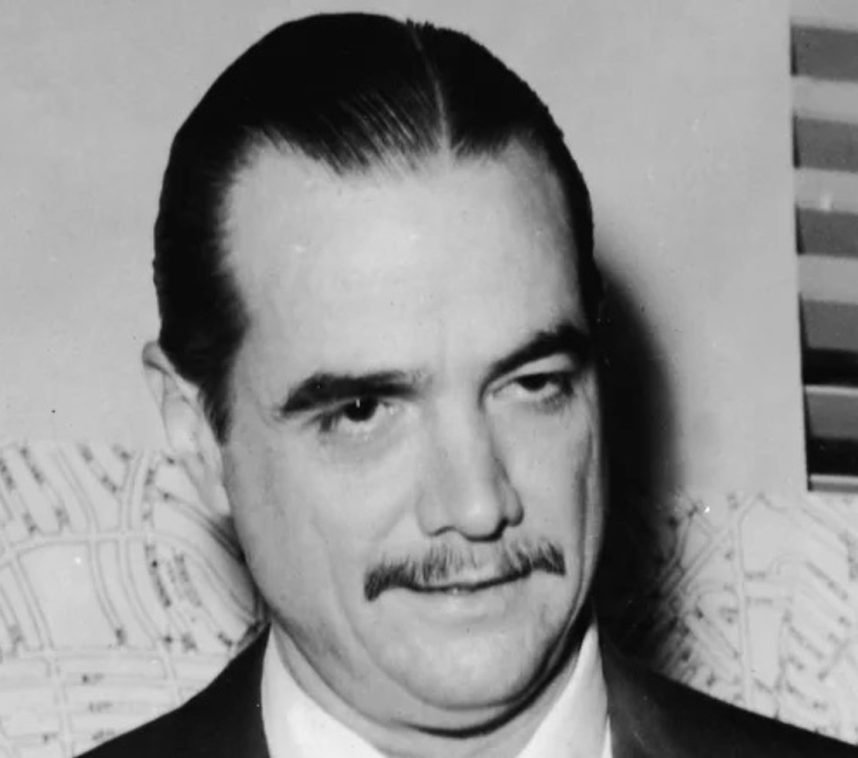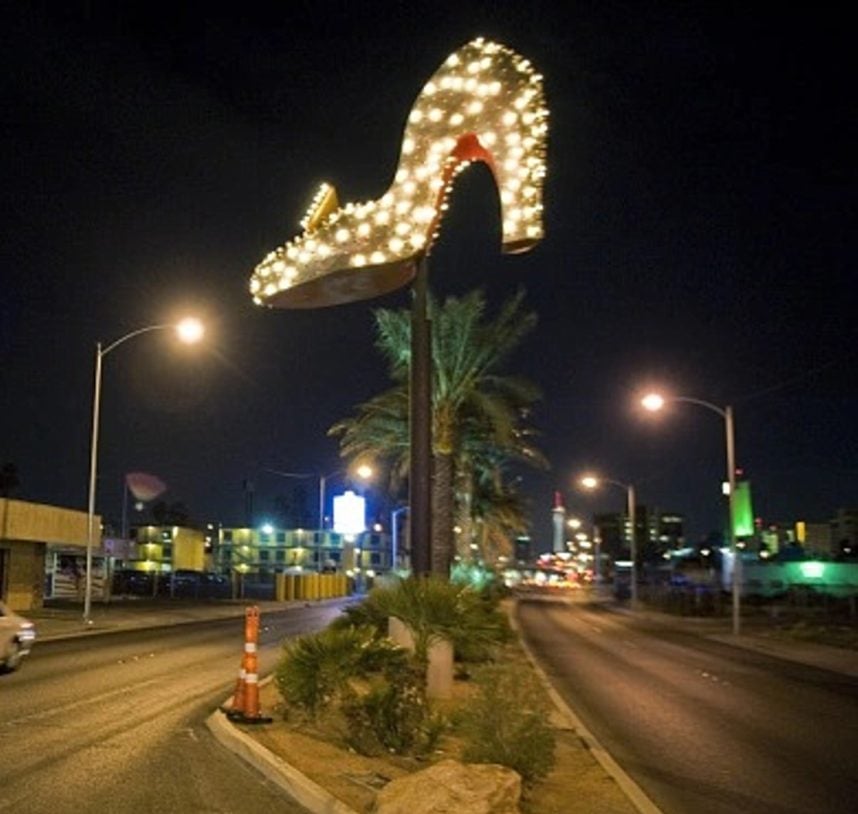EDITOR’S NOTE: “Vegas Myths Busted” publishes unexampled entries every Monday, with a fillip Flashback Friday edition. Today’s entry in our on-going series originally ran on May 1, 2023.
This is already our second Leslie Howard Charles Evans Hughes myth, and in that location are allay a bundle left hand to bust. Supposedly, the world-famous aeronaut and pic tycoon began his famous purchasing fling of Las Vegas cassino hotels, partly freeing the Strip from the shackles of mafia ownership and paving material the path for the age of incorporated ownership, all thanks to the monster shoe atop the Silver Slipper.
The 12-foot tall, 17-foot wide, rotating richly heel was intentional by Jack Larsen Sr., a former Walter Elias Disney animator who worked for the YESCO subscribe company, where he also created the pop-art lamp for Aladdin. Patterned after ace of his wife’s pumps, Larsen’s Silver Slipper sign up boasted 900 incandescent lightbulbs on the shoe and 80 on the bow. It was installed in late 1954 or ahead of time 1955 and was deployed until the resort unsympathetic inward November 1988.
According to the story, the shoe, set straight crossways the Strip from the Desert Inn, where Howard Robard Hughes had taken upwards since arriving inwards Las Vegas the twenty-four hour period before Thanksgiving inward 1966, was too smart for Charles Evans Hughes to sopor at night.
The Silver Slipper refused Hughes’ requests to dim the shoe, the story goes, so he bought the cassino hotel and dimmed it himself. This gave the eccentric billionaire a taste perception for acquiring Vegas hotels, and he bought a caboodle more.

This myth has appeared in books including “The Strip: Las Vegas and the Architecture of the American Dream” (2022) and “When the Mob Ran Vegas: Stories of Money, Mayhem and Murder” (2005), and inwards publications as logical as the Los Angeles Times.
As is often the showcase with urban myths, it also comes inwards other variations. The single featuring on the current variant of the Silver Slipper’s Wikipedia entry has Charles Evans Hughes believing that the slipper’s toenail “could hold a photographer taking pictures of him.” After several attempts at requesting that the slipper live turned off, according to the entry, “Hughes purchased the casino, turned away the lights, and had the rotating system of rules dismantled.”
Both of those stories are fill out meaninglessness — complete nonsense,” Alice Paul Winn, Hughes’ theatre director of collective records from 1957 through Hughes’ dying inward 1976, told Casino.org. “I don’t live where they come up upwardly with this stuff.”
Of course, as is usual with Hughes, the trueness was as strange as the fiction. We’ll receive to that later.
Four Main Problems With This Story
According to Winn and all other accounts of Hughes’ time in his Desert Inn penthouse suite, he kept the drapes drawn 24/7.
- No gambling casino sign’s light or photographer’s lense could maybe get penetrated them. Hughes, no more question deeply inwards the grips of mental unwellness past that point, demanded shut curtains (and windows) to protect him from pollution, sunlight, germs, prying eyes, and atomic fallout from the habitue resistance explosions at the nearby Silver State Test Site. According to Winn, Edward James Hughes tried getting President Lyndon President Lyndon Johnson to layover those tests, but yet he wasn’t powerful enough.
- The dates are wrong. Hughes’ purchasing spree began inward Mar 1967. He didn’t purchase the Silver Slipper until Apr 30, 1968.
- The Frontier’s sign on was bigger and brighter than the Silver Slipper’s, so it would have stung Ted Hughes more.
- We cognize where the myth came from — an erroneous Las Vegas Review-Journal study that was later retracted.
Well, it was sort of retracted.
On April 21, 1967, R-J gossiper editorialist Earl Woodrow Wilson wrote: “Associates say (Hughes) had them bespeak the Silver Slipper to vague its lights. They refused. His emissaries say he has instructed them to negotiate for the purchase of the Slipper so it testament no yearner interfere with his sleep.”
Almost a good yr later, piece Hughes’ Silver Slipper purchase was closing, Sir Angus Wilson published what journalists come to to as a “non-correction correction,” inward which he dishonored his previous false title without really admitting that he was its origin. (There was no more internet backwards so to match him.)
He’s not closing it pull down and he’s not turn out the lights,” Thomas Woodrow Wilson wrote of Hughes’ imminent Silver Slipper takeover on April 17, 1968. “They power even combust brighter than ever.”
Wilson’s review proven too veiled a cite for most readers to still link up it to his original report, which is the 1 they continued to remember.
What Really Happened
The Desert Inn rented its entire upside level and the base at a lower place it to Ted Hughes and his associates for 10 days. Check-out time came and went, and Edward James Hughes didn’t budge. DI co-owners Moe Dalitz and Ruby Kolod freaked. They had already promised the suites to high-pitched rollers for New Year’s Eve.
Robert Maheu, Hughes’ top off aide, had Teamsters Federal chairwoman Jimmy James Riddle Hoffa interpose on Hughes’ behalf, but that only if bought a match of more weeks. Maheu and so suggested purchasing the DI to his hirer as the only solution. And that’s how Hughes’ famous purchasing fling began.
“Hughes never intended to buy a hotel — he just wanted a put to sleep,” Maheu told PBS inwards 2005.
As mentioned earlier, the trueness is usually as strange as the fiction with Hughes.
On Mar 27, 1967, Howard Hughes and Dalitz in agreement(p) on a price: $13.2 million, far to a greater extent than the DI was worth. Langston Hughes and so purchased the Sands for $14.6 million, the Frontier for $23 million, the El Rancho Vegas for $7.5 million, the Castaways for $3 million, the unfinished Landmark for $17 million, and the Silver Slipper for $5.4 million.
“He bought the Silver carpet slipper because it was available, no more other reason,” Winn told Casino.org. “I know. My epithet was on the gaming permission because I was a incorporated officer.”

Asked if he knew wherefore the slipper sign on eventually stopped-up(a) rotating, Winn replied: “My pretend would live that the rotating mechanics broke, and in all probability nobody bothered to prepare it.”
The Silver Slipper was sold inwards 1988 to hotelman Margaret Elardi for $70 million. She razed it and turned it into a parking lot for the Frontier, which she also owned. Fortunately, the carpet slipper and its signalise were salvaged and retired to YESCO’s boneyard, which later became the Neon Museum’s collection.
Yet another variation on the myth had Hughes order concrete poured into the rotary motion mechanics to cram it. According to the Neon Museum, no more concrete was found inward the chemical mechanism when they acquired the sign.
In 2009, the museum restored the mark and installed it, on with other vintage Vegas atomic number 10 signs, in a medial along Las Vegas Boulevard North, where it relieve shines today.
Look for a new “Vegas Myths Busted” every Mon on Casino.org. Visit VegasMythsBusted.com to record previously busted Vegas myths. Got a proposition for a Vegas myth that needs busting? Email corey@casino.org.